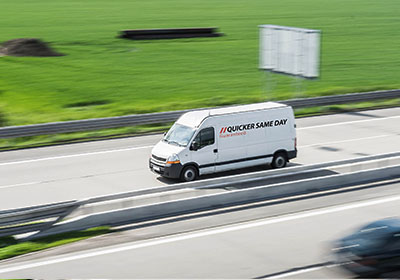Same day delivery is becoming more and more common for many businesses and individuals alike.
With a growing desire for this service, the places that same day delivery firms, such as Quicker Same Day, have to deliver to is ever growing.
Take our list of locations for example. This ranges from Scotland to London, with many stops in between.
The areas we can deliver to are split into two sections, urban and rural.
Urban is the big cities, such as Manchester, Birmingham, and Liverpool. Rural are the less populated places that are spread throughout the country, such as villages and small towns.
The dynamics of same day delivery vary significantly between urban and rural areas, presenting unique challenges and requiring tailored solutions.
In this blog, we’ll explore the distinct challenges faced by delivery businesses in each setting and delve into potential strategies to overcome them.
Let’s take a look.
Challenges in Urban Areas
1. Traffic Congestion
Urban city centres are often plagued by heavy traffic, which can lead to delivery delays.
Especially around the peak hours before and after work, navigating through congested streets can slow down delivery times and hinder the promise of same day delivery.
In London, for example, you can expect to be travelling for over 35 minutes just to go 10km in rush hour traffic.
In regular traffic, this time would be much shorter, so you can see why this may be a burden on getting a delivery to its destination in the quickest time possible.
2. Last-Mile Logistics
The density of buildings and residences in urban areas can complicate last-mile logistics.
Delivering packages to specific addresses within densely populated neighbourhoods can be challenging and time-consuming.
Firstly, there is the issue of navigating smaller streets in search of an address. Especially when in larger vehicles, such as freight deliveries, and Hiab and Moffett deliveries, this can be tricky and in some cases impossible.
The last mile of a delivery is often the most tricky, and the most important, and any issues here can cause you to miss your delivery slot and upset the recipient.
3. Limited Parking and Accessibility
Parking constraints and limited access to delivery drop-off points can impede quick and efficient deliveries.
Delivery vehicles may struggle to find suitable parking spots or encounter obstacles that delay the process.
This can be counted in the last mile delivery issue, as finding somewhere to stop, unload, and park while delivering the parcel can slow down a delivery.
The further away you park, the longer it takes to reach your destination on foot.
4. High Demand and Volume
Urban areas often have a higher concentration of customers, resulting in a larger volume of same day delivery orders.
Fulfilling a high number of orders within a short timeframe requires efficient logistics and resource allocation.
This can cause many problems for logistics firms, including running out of vehicles, confusing orders, or not being able to process them in a quick enough time.

Solutions for Urban Areas
1. Route Optimization
Implement advanced route optimization software to navigate through traffic and find the most efficient paths for deliveries, reducing transit times and enhancing the accuracy of delivery windows.
This software often updates in real-time, so will alert you to any issues that may cause one route to no longer be the quickest way.
Having experienced drivers who also know city centres and know the best roads to take is advantageous here.
2. Strategically Placed Hubs
Establish hubs that are strategically located within urban areas to enable quicker order processing and reduce the distance between the warehouse and delivery points.
What this means is that in every city you have a location from which the fleet can be kept that is close to any destination that they may be needed.
With this in place, as soon as an order comes in, a collection can be underway and there should never be a huge journey ahead.
3. Smart Locker Solutions
Utilize smart locker systems located in convenient urban locations, such as shopping centres or transit hubs, to enable contactless and secure same day deliveries.
This is a great way of eliminating any final mile issues and also losing the need for so much flexibility when it comes to a delivery slot.
With smart lockers and other storage solutions, the parcel can be left in a place convenient for driver and recipient and can be collected anytime in the near future.
Challenges in Rural Areas
1. Longer Distances
Rural areas often cover larger geographic areas, resulting in longer distances between delivery points. This can make it logistically challenging to deliver within the same day.
With more space to cover, the miles can rack up when travelling from the collection point to make the delivery, so while the roads may be less busy and it is quicker to travel, same day delivery can be hard to maintain.
2. Limited Infrastructure
Sparse road networks and challenging terrains in rural areas can hinder delivery vehicles and slow down the delivery process.
If roads are bumpy, or small, then they may be unsuitable for some vehicles, which makes the deliveries hard to make.
These roads can also slow things down, especially when stuck behind slow vehicles or having to slowly guide your way through tricky conditions.
3. Low Population Density
The lower population density in rural areas can lead to fewer delivery orders, making it economically challenging to offer same day delivery without incurring high costs.
Without the demand for same day delivery, there may not be the desire for such a service, and it could be tough to grow a business.
In these areas, people are often less inclined to expect such a delivery service as well, with it being much more common in urban areas.

Solutions for Rural Areas
1. Hub-and-Spoke Model
Adopt a hub-and-spoke distribution model, where goods are delivered to strategically placed hubs in rural areas, and then local deliveries are made from these hubs to reduce overall travel distances.
This is much like the hub approach mentioned in the urban category, but the hubs would be much further spread out. This means more rural areas in reach in quicker times, and a same day delivery is possible.
2. Partnering with Local Businesses
Collaborate with local businesses in rural areas to act as pick-up points or distribution centres, leveraging their existing infrastructure to facilitate efficient deliveries.
If you can build up these partnerships, then you will always have somewhere handy to quickly get a delivery underway or completed.
Last mile delivery is tough in rural areas, so having a collection point that you know is easily accessible is a big help.
3. Flexible Delivery Scheduling
Offer flexible delivery windows that align with the unique schedules and lifestyles of rural customers, accommodating their preferences for when they would like to receive their orders.
Offer plenty of time slots and even stretch into the evening if you can.
The deliveries to these locations are unpredictable, with more distance to travel, so be open and communicative in case anything changes.

Quicker Same Day Rural and Urban Deliveries
Same day delivery presents distinct challenges and opportunities in urban and rural areas.
While urban areas grapple with traffic congestion and high demand, rural areas face longer distances and limited infrastructure. Retailers aiming to provide seamless same day delivery services must tailor their strategies to address these challenges.
At Quicker Sameday, we offer a comprehensive same day delivery service with a wide range of vehicles and locations that we deliver to.
If you would like to take advantage of our speedy service, then get in touch today or fill in your journey information for a free quote.








